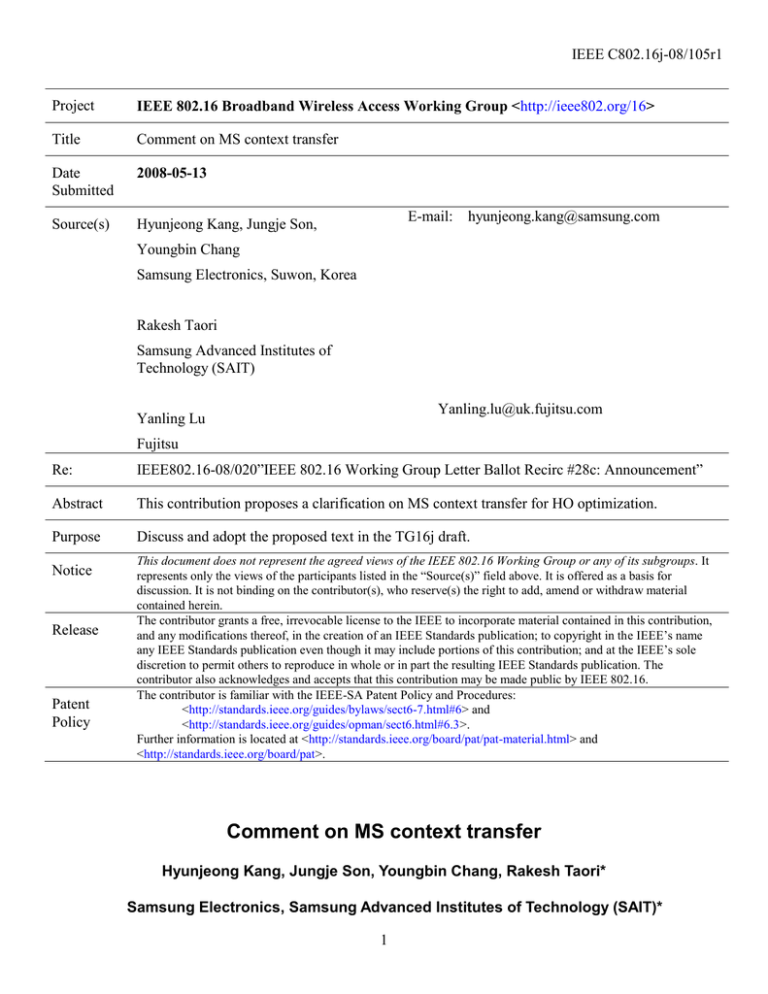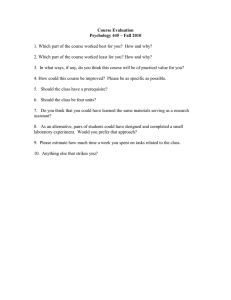IEEE C802.16j-08/105r1 Project Title
advertisement

IEEE C802.16j-08/105r1 Project IEEE 802.16 Broadband Wireless Access Working Group <http://ieee802.org/16> Title Comment on MS context transfer Date Submitted 2008-05-13 Source(s) Hyunjeong Kang, Jungje Son, E-mail: hyunjeong.kang@samsung.com Youngbin Chang Samsung Electronics, Suwon, Korea Rakesh Taori Samsung Advanced Institutes of Technology (SAIT) Yanling.lu@uk.fujitsu.com Yanling Lu Fujitsu Re: IEEE802.16-08/020”IEEE 802.16 Working Group Letter Ballot Recirc #28c: Announcement” Abstract This contribution proposes a clarification on MS context transfer for HO optimization. Purpose Discuss and adopt the proposed text in the TG16j draft. Notice Release Patent Policy This document does not represent the agreed views of the IEEE 802.16 Working Group or any of its subgroups. It represents only the views of the participants listed in the “Source(s)” field above. It is offered as a basis for discussion. It is not binding on the contributor(s), who reserve(s) the right to add, amend or withdraw material contained herein. The contributor grants a free, irrevocable license to the IEEE to incorporate material contained in this contribution, and any modifications thereof, in the creation of an IEEE Standards publication; to copyright in the IEEE’s name any IEEE Standards publication even though it may include portions of this contribution; and at the IEEE’s sole discretion to permit others to reproduce in whole or in part the resulting IEEE Standards publication. The contributor also acknowledges and accepts that this contribution may be made public by IEEE 802.16. The contributor is familiar with the IEEE-SA Patent Policy and Procedures: <http://standards.ieee.org/guides/bylaws/sect6-7.html#6> and <http://standards.ieee.org/guides/opman/sect6.html#6.3>. Further information is located at <http://standards.ieee.org/board/pat/pat-material.html> and <http://standards.ieee.org/board/pat>. Comment on MS context transfer Hyunjeong Kang, Jungje Son, Youngbin Chang, Rakesh Taori* Samsung Electronics, Samsung Advanced Institutes of Technology (SAIT)* 1 IEEE C802.16j-08/105r1 Yanling LU Fujitsu 1. Introduction This contribution proposes to clarify the operation of MS context transfer in MR system. MS context transfer operation is described in IEEE 802.16j draft [1] to support the optimized HO of MS. In the operation description, a term ‘Station’ is applied to both MR-BS and RS, and it may make confusion to understand the operation. So it is better to use ‘RS’ or ‘MR-BS’ when it is needed to distinguish the entities from each other. 2. Proposed text change [Change subclause 6.3.22.2.11.3 as follows:] When an MS performs optimized HO in an MR network, MS context, such as MS supporting physical parameters and MAC features, Service Flow parameters and Security context (if operating in distributed security mode), should be transferred to the target station. There are two ways to transfer MS context, Serving station initiated transfer and Target station initiated transfer. In the Serving station initiated transfer for distributed security mode, the serving station may initiate MS_Context-REQ with type=0 (notification), when it receives MOB_MSHO/BSHO-REQ or MOB_HO-IND message. — When the serving station is the MR-BS and the target station is its subordinate RS, the MR-BS sends the MS_Context-REQ to the target RS. — When the target station is the MR-BS of the serving station (RS), the serving RS sends the MS_ContextREQ to the MR-BS. — When the serving RS and target RSstation areis another RS within under the same MR-BS cell, the serving RSstation sends the MS_Context-REQ message to the target RSstation through the MR-BS. — When the serving station is an RS, the RS shall not include MS_Context TLVs which the MR-BS also possesses. Instead, the MR-BS shall add its possessing MS_Context TLVs to the received MS_Context-REQ message and sendt it to the target station. — In response to the MS_Context-REQ, tThe target RSstation and or MR-BS send MS_Context-RSP with type=0 (acknowledgement) to the sender of the MS_Context-REQ. — When the target station does not exist in the same MR cell, the serving MR-BS communicates with the target MR-BS for sends MS context to the target MR-BS over via the backbone network. Protocol of backbone network is out-of-scope of this document. In the Serving station initiated transfer for centralized security mode, the MR-BS may send MS_Context-REQ with type=0 (notification) to the target RS, when it sends MOB_BSHO-REQ to MS or it receives MS context over the backbone network, or it receives MOB_MSHO -REQ or MOB_HO-IND message from MS. Then, the 2 IEEE C802.16j-08/105r1 target RS sends MS_Context-RSP with type=0 (acknowledgement) to the MR-BS. Figures 157e and 157f show examples of serving station initiated transfer in MS handover operation in IntraMR and Inter-MR operating in distributed security mode, respectively. In the examples, the MS_Context-REQ message sent by the serving RSstation contains SS MAC Address TLV, BSID TLV and TLVs related to MS context. The BSID TLV represents the target station. Therefore, when the MR-BS receives the MS_ContextREQ from the serving RS, it examines the BSID TLV. If the BSID TLV indicates the MR-BS itself, the MR-BS sends back MS_Context-RSP to the serving RS. If it indicates a subordinate RS of the MR-BS, the MR-BS sends MS_Context-REQ with type=0 to the subordinate RS after removing BSID TLV. Then the subordinate RS sends back MS_Context-RSP to the serving RS through the MR-BS. If the BSID does not indicate a station within the MR cell, the MR-BS sends a message to the backbone network to inform the target station of MS context. In the case of RSs operating in centralized security mode, message exchanges between the target RS and the MR-BS in the figures 157e and 157f are performed. In the target station initiated transfer for distributed security mode, the target station may initiate MS_ContextREQ with type=1 (request), when it receives a RNG-REQ message containing the Serving BSID TLV from an MS and does not possess context of the MS. — When the target station is the MR-BS and the serving station is its subordinate RS, the MR-BS sends the MS_Context-REQ to the serving RS. — When the target station is the RS and the serving station is its MR-BS, the target RS sends the MS_ContextREQ to the MR-BS. — When the serving RS and target RS arestation is another RS within under the same MR-BS cell, the target 3 IEEE C802.16j-08/105r1 RSstation sends the MS_Context-REQ message to the serving RS station through the MR-BS. — The serving RSstation and MR-BS send MS_Context-RSP with type=1 (response) in response to the MS_Context-REQto the sender of the MS_Context-REQ. — When the serving station is an RS, the RS shall not include MS_Context TLVs which the MR-BS also possesses. Instead, the MR-BS shall add its possessing MS_Context TLVs to the received MS_Context-RSP message and sendt it to the target station. — When the serving station does not exist in the same MR cell, the target MR-BS sends request to the serving MR-BS over the backbone network to obtain MS context. Protocol of backbone network is out-of-scope of this document. In the target station initiated transfer for centralized security mode, the target RS may send MS_Context-REQ with type=1 (request) to the MR-BS, when it receives a RNG-REQ message containing the Serving BSID TLV from an MS and does not possess context of the MS. Then, the MR-BS sends MS_Context-RSP with type=1 (response) to the target RSstation. When the serving station does not exist in the same MR cell, the target MRBS communicates with the serving MR-BS for the MS context via backbone network sends request to the serving MR-BS over the backbone network to obtain MS context. Protocol of backbone network is out-of-scope of this document. Figures 157g and 157h show examples of target station initiated transfer in MS handover operation in Intra-MR and Inter-MR operating in distributed security, respectively. In the examples, the MS_Context-REQ message sent by the target station contains SS MAC Address TLV, BSID TLV. The BSID TLV represents the serving station. Therefore, when the MR-BS receives the MS_Context-REQ from the target RS, it examines the BSID TLV. If the BSID TLV indicates the MR-BS itself, the MR-BS sends back MS_Context-RSP to the target RS. If it indicates a subordinate RS of the MR-BS, the MR-BS sends MS_Context-REQ with type=1 to the subordinate RS after removing the BSID TLV. Then the subordinate RS sends back MS_ContextRSP in response to the MS_Context-REQ and the MS_Context-RSP is sent to the target RS through the MR-BS. The MS_Context-RSP should contain TLVs related to MS context. If the BSID does not indicate a station within the MR cell, the MR-BS sends a message to the backbone network to inform the servingtarget station of the request for MS context. The message sent to the backbone is out of scope of this specification. In the case of RSs operating in centralized security mode, message exchanges between the target RS and the MR-BS in the figures 157g and 157h are performed. 4 IEEE C802.16j-08/105r1 Reference: [1] IEEE P802.16j/D4 April 2008 5

